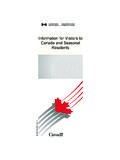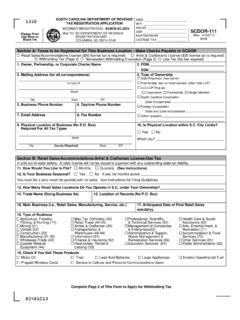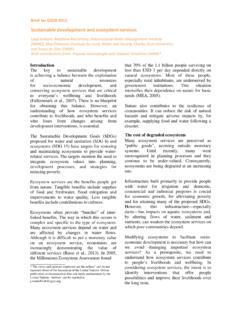Transcription of U.S. COAST GUARD: Frequently Asked Questions …
1 COAST guard : Frequently Asked Questions (FAQ) regarding TWIC Enforcement TSA and USCG are responsible for implementing the TWIC (Transportation Worker Identification Credential) program. The USCG is responsible for: 1) enforcing TWIC compliance, 2) providing guidance to assist industry with compliance, 3) conducting spot-check/annual inspections, 4) reviewing and approving security plans, and 5) working with TSA towards successful integration. To address TWIC enforcement Questions from industry stakeholders and CG field units, a Help Desk was established. Having a central means to filter Questions /concerns allows us to establish internal policies to consider issues for subsequent policy guidance and to centralize responses. The following FAQ s were sent to USCG s TWIC Help Desk which include commonly Asked enforcement Questions . We hope they prove to be beneficial as we work together to improve maritime security within our US ports.
2 If you have additional Questions or concerns, USCG s TWIC Help Desk can be reached by phone at ( ), Option 1 or by e-mail at 1. Does a security plan need to provide a list of employees who have a TWIC? A. No, owners/operators are not required to maintaining a list of employees who have a TWIC. However, owners/operators may voluntarily provide this information within their security plan. 2. We have a number of seasonal/casual workers which include high school students. Our operation increases during the summer and we hire several part-time staff that will be employed for a few months before they are laid off as operations slow down. Taking the nature of our business into consideration, will all of our personnel be required to obtain a TWIC? A. If an individual requires routine unescorted access to secure areas of a vessel or facility, he/she will need to obtain a TWIC or be escorted by an individual who has a TWIC. For passenger vessels, the ability to designate passenger and employee access areas may exclude many seasonal workers from the TWIC requirement.
3 The vessel owner/operator must designate the passenger and/or employee access areas in accordance with 33 CFR , 3. Will the New Hire process be applicable for seasonal/casual workers? A. The New Hire provision is granted at the owner/operators discretion and only applies to direct employees. Since there may be a delay between when an employee begins work and when they receive their TWIC, the New Hire provision can be used for seasonal/casual workers. Further guidance is outlined in NVIC 03-07, section h. 4. The NVIC Enclosure 3, (1) (d) 3) i. states that if a new hire is working in a restricted area, they must be monitored in accordance with (2) (b). However, the first example in this referenced section states that the task should not take the individual into any restricted areas as side-by-side accompaniment would be required. Could you elaborate since this is contradictory? A. The last statement does not apply to new hires.
4 Therefore, the new hires can be accompanied by monitoring in a restricted area as long as the New Hire provision has been properly followed. 5. How do I re-define the non-maritime transportation related portions of my facility? A. For facilities to utilize this provision, amendments should have been submitted to the COTP no later than September 4, 2007. However, a facility may request permission from the COTP to submit a redefinition beyond this date. The COTP will consider each request based upon individual circumstances. It should be noted that redefinition of non-maritime transportation related portions does not eliminate the need to implement access control procedures as approved in the Facility Security Plan. The overall footprint of the facility will remain regulated by 33 CFR 105. If approved by the COTP, this provision merely limits the facilities implementation of TWIC to include those portions with a maritime transportation nexus.
5 COTPs should accommodate redefinition to exclude non-maritime transportation areas involved in refining, manufacturing, production, power generation, and other activities as discussed in NVIC 03-07. In addition, COTPs should accommodate requests from passenger vessel facilities to exclude non-maritime transportation areas such as retail shops, galleys, and restaurants from secure areas. Further guidance regarding this provision is outlined within NVIC 03-07 enclosure A. 6. Does the redefinition provision for non-maritime transportation related portions mean that I m unable to amend my security plan beyond September 4, 2007? A. In no way does the above mentioned provision limit an owner/operator s ability to amend their security plans. This could have been done pre-TWIC and nothing within the TWIC requirements will restrict this option now. The amendment process is outline in 33 CFR , , and The COTP should address such an amendment in the same manner he/she would have done pre-TWIC ( , assess the request to redefine the restricted area in light of the facilities FSA Report and the measures outlined in the amended plan, to ensure adequate security is provided).
6 7. If TWIC is integrated into an existing electronic access control system in accordance with NVIC 03-07, why is an individual required to keep the TWIC on their person? If the access control system indicates the individual already has a valid TWIC, it is an extra effort and liability to require two cards (TWIC & facility access card) be carried at all time. A. Per the TWIC Final Rule, individuals who have been issued or possess a TWIC must present the credential upon request from the TSA, COAST guard , or other authorized DHS representative; an authorized representative of the National Transportation Safety Board; or a Federal, State, or local Law Enforcement Officer. Additionally, since the TWIC is not being used as a visual identity badge on a daily basis, the Facility Owner/Operator is required to conduct random visual checks for TWIC. Therefore, either the individuals granted unescorted access will need to carry the TWIC on their person when they are in a secure area or the credentials may be secured in a convenient location where they can be retrieved and presented within a reasonable amount of time (ten minutes or less).
7 8. If TWIC is integrated into an existing electronic access control system which already uses biometrics to verify the identity of the individual requesting access, would the owner and operator still have to comply with the "flash pass" requirements in the TWIC NVIC? A. In no situation should an employee be issued a vessel or facility-specific card which allows unescorted access to a secure area without first ensuring that the individual possesses a TWIC. The TWIC does not need to be used as a visual identity badge at each entry once the facility-specific card is issued. However, the NVIC does state that since the TWIC is not being used as a visual identity badge on a daily basis, the Facility Owner/Operator must ensure that random visual checks for TWIC are implemented to ensure employees continue to keep their TWIC on their person or in close proximity. As noted above, employees may also be required to present the credential upon request from the TSA, COAST guard , or other authorized DHS representative; an authorized representative of the National Transportation Safety Board; or a Federal, State, or local Law Enforcement Officer.
8 9. How are you supposed to perform the 1 to 5 escort ratio for truckers in a restricted area? A. Due to the nature of operations, it is not feasible to perform the 1 to 5 escort ratio for truckers in a restricted area. Recommended escort should be 1 escort vehicle in close proximity to 1 truck in a restricted area. 10. Truckers should have the same compliance date as mariners and vessels. Why is this not the case? A. In conducting research for the economic analysis that accompanied the TWIC final rule, TSA determined that the majority of truckers are short-haul "drayage" truckers and generally operate within one COTP zone which enables them to apply for and receive a TWIC at the local enrollment center. Truck drivers would need to utilize any number of identification cards for access until they received a TWIC, which defeats the purpose of TWIC. Mariners are an inherently more mobile population and have distinct federal credentials that must be utilized for access until they receive their TWIC.
9 11. How will individuals prove to the owner or operator that they have reported their TWIC lost or stolen? A. Currently there are no procedures available for a CSO/VSO/FSO to verify that an individual has reported their TWIC as lost or stolen. However, this will be added to the list of system upgrades to be included as soon as possible. This provision is for direct hires of a company. Therefore, if there are no suspicious circumstances associated with the individual's claim and the CSO/VSO/FSO can confirm that the individual did have a valid TWIC, then unescorted access can be granted for up to seven consecutive days. 12. regarding emergency response during increased MARSEC levels, are there any special provisions to allow a relaxation of the escorting requirements to facilitate response and recovery? If not, why? A. During heightened MARSEC levels, security requirements would be increased, not decreased. Emergency and Law Enforcement personnel would have unescorted access to a facility for response and recovery activities without a TWIC.
10 13. Is there any process for fast tracking TWIC applications for individuals with security responsibilities? If not, why? A. There is no "fast track" option or capability for individuals with security duties. These individuals have the same opportunity to apply for and receive a TWIC prior to compliance. Once compliance is in effect, proper planning must be utilized to ensure they have received a TWIC prior to conducting security duties. 14. How do we determine which state/local officials qualify for the Law Enforcement provision? A. To qualify for the Law Enforcement provision, state/local statutes must define the individual s position and/or agency as a law enforcement officer/official. A Policy Advisory Council (PAC) decision has been posted on the COAST guard s Homeport website to provide further guidance. 15. Can a US federal employee or contractor use their CAC card to be eligible for unescorted access to a MTSA facility and/or vessel?







